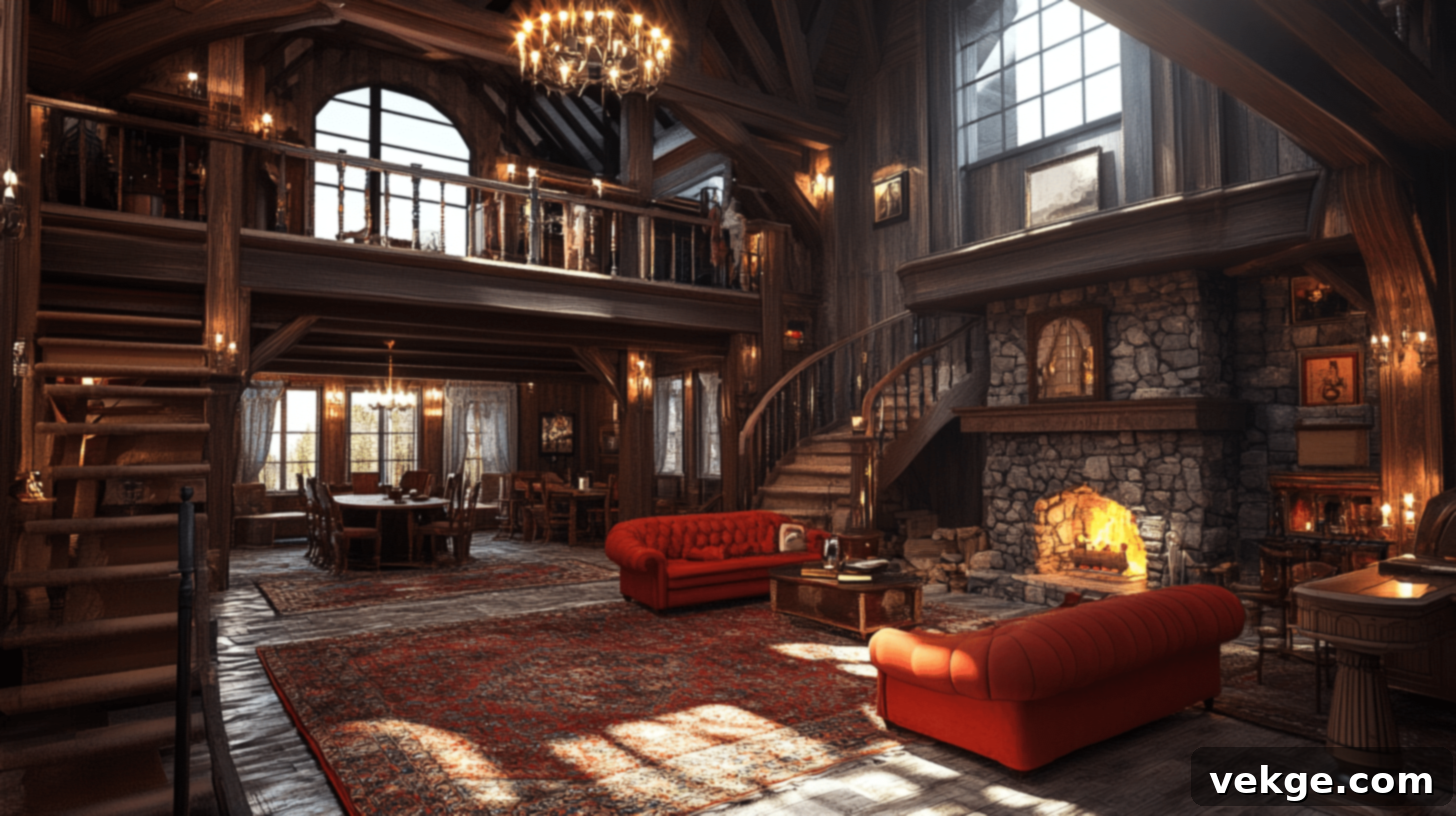Elevate Your Home: The Ultimate Guide to Decorating High Ceilings for Warmth and Style
Moving into a home with towering ceilings, perhaps 14 feet high like mine, presents a unique challenge. While initially breathtaking, the sheer vertical expanse can quickly make rooms feel cold, cavernous, and unfinished. For months, I found myself staring at vast, empty walls, struggling to envision how to transform these grand spaces into something truly warm and inviting.
The good news is, you absolutely can make those impressive high ceilings work in your favor. Through careful experimentation and understanding fundamental design principles, I discovered practical, cost-effective ways to fill the vertical void without requiring complex installations or specialized tools. This guide compiles those learnings, offering simple yet impactful strategies to style your tall ceilings. We’ll explore how to strategically choose and place decorations, ensuring your space feels cozy, balanced, and aesthetically pleasing, all without breaking the bank.
Mastering the Heights: Essential Design Principles for High Ceilings
Decorating high ceilings requires a thoughtful approach that differs from standard-height rooms. Here are the core design principles that proved invaluable in transforming my lofty spaces:
- Embrace Scale and Balance: Large rooms with high ceilings demand larger decorative elements. Small, delicate items tend to get lost in vast spaces, emphasizing their emptiness rather than filling them. Opt for substantial artwork, oversized mirrors, or grand light fixtures that command attention and proportionally match the wall’s expansive size. Think big to create impact and visual weight.
- Strategic Height Distribution: Visualizing the wall in three distinct horizontal sections—bottom, middle, and top—can revolutionize your decorating process. This method helps distribute visual interest evenly. Place heavier, more grounded items like furniture or large, low-hanging artwork in the bottom third. The middle section is ideal for eye-level art groupings or shelving. The top third can accommodate lighter elements like extended drapery, higher shelves, or the upward reach of tall plants, drawing the eye naturally upwards without making the space feel top-heavy.
- Harmonious Color Flow: A cohesive color palette is crucial for connecting the various levels of a tall room. When selecting colors for the upper walls, ensure they complement the hues found in your furniture, rugs, and floor-level decorations. This creates a seamless visual flow from the ground up, preventing the room from feeling disjointed or segmented. Gradual transitions in color, or using different shades of the same color, can also beautifully achieve this harmony.
- Play with Light and Shadow: Understanding how natural light interacts with your walls is key. Brightly lit areas, often near windows, are perfect for showcasing reflective surfaces like mirrors or vibrant artwork. Conversely, darker or shadowed sections can benefit from artificial lighting, such as wall sconces, or decorations with metallic finishes that can catch and amplify subtle light. Strategic lighting can define zones and add depth to the vertical expanse.
- Maintain Simple, Clean Lines: In a tall room, clutter can quickly overwhelm and make the space feel chaotic. Sticking to clean, straight lines in your décor choices, whether it’s framed art, shelving, or furniture, helps maintain an organized and elegant aesthetic. When hanging items, ensure they align logically with the room’s architecture, creating a sense of order and sophisticated simplicity.
These foundational principles serve as a powerful framework, simplifying the decision-making process for decorating high-ceiling rooms and ensuring your choices contribute to a cohesive, comfortable, and stylish environment.
Practical Approaches to Decorating High Ceilings
1. Dynamic Paint Effects ($100-200)
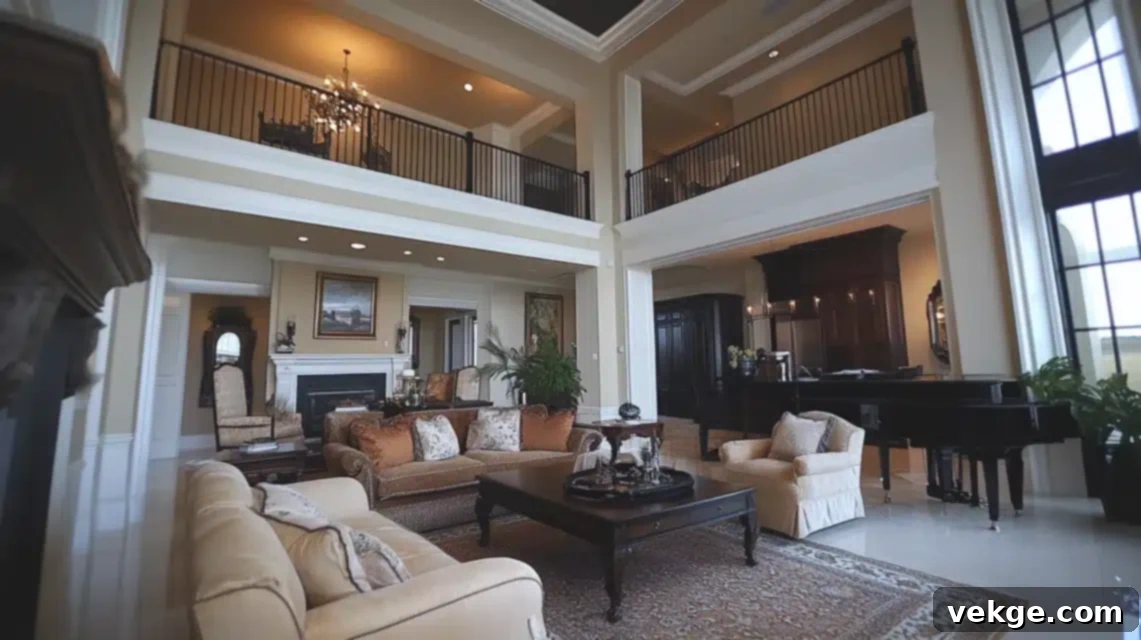
One of the most transformative yet budget-friendly solutions for high ceilings is strategic paint application. Utilizing two complementary paint colors can dramatically alter the perception of height. By painting the lower section of your walls a darker shade and the upper part a lighter hue, you create a visual horizon line that effectively “lowers” the ceiling, making the room feel more balanced and intimate rather than overwhelmingly tall. This technique visually grounds the space while allowing the upper portion to remain airy.
A weekend project and two gallons of paint (approximately $50 per gallon) plus basic painting tools can revitalize your room. A pro tip is to paint the bottom third of the wall a darker, grounding color, which creates a cozy, contained feeling in the living zone, while the lighter color above keeps the room from feeling too heavy or closed-in.
2. Engaging Wall Art Groups ($150-400)
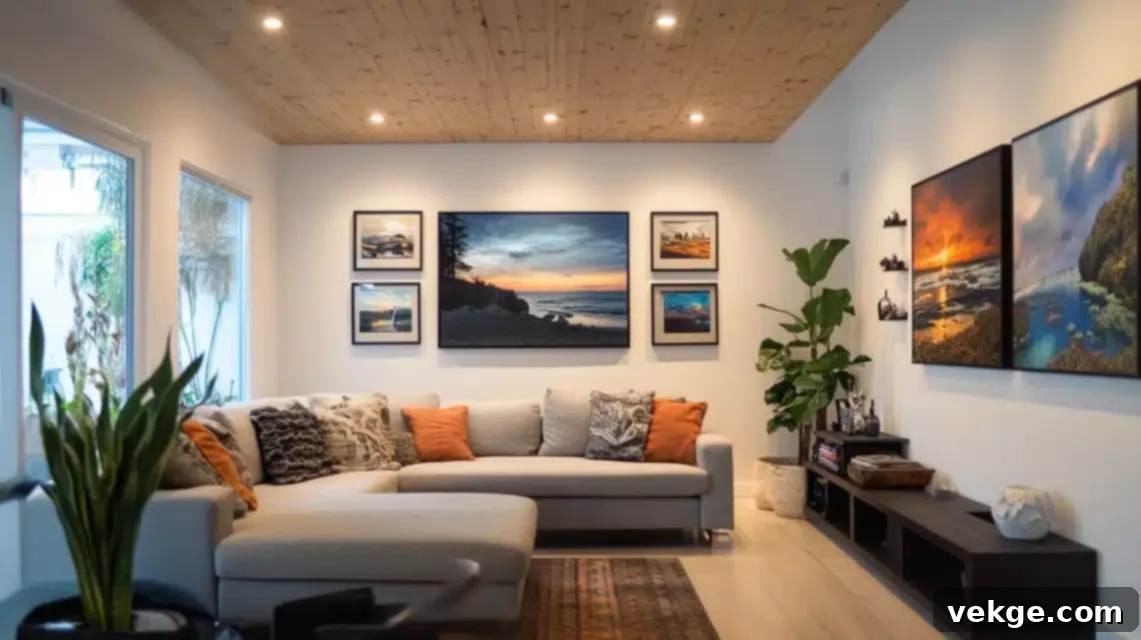
Instead of relying on a single, massive piece of art that can be costly and difficult to scale, consider creating a gallery wall or a series of art pieces arranged to draw the eye upwards. By hanging several medium to small pieces in a thoughtful grouping, perhaps extending vertically or in a climbing pattern, you can effectively fill the vast wall space without overwhelming it. This approach adds visual texture and interest while allowing for personalization and flexibility.
You don’t need expensive gallery art. I achieved a stunning effect by purchasing six medium frames (each costing between $25-50) and filling them with affordable prints, photographs, or even DIY abstract art. Arranging them in a pattern that ascends the wall, perhaps along a staircase or in a linear progression on a flat wall, creates a dynamic focal point that naturally engages the high ceiling.
3. Verdant Tall Plants ($75-200)
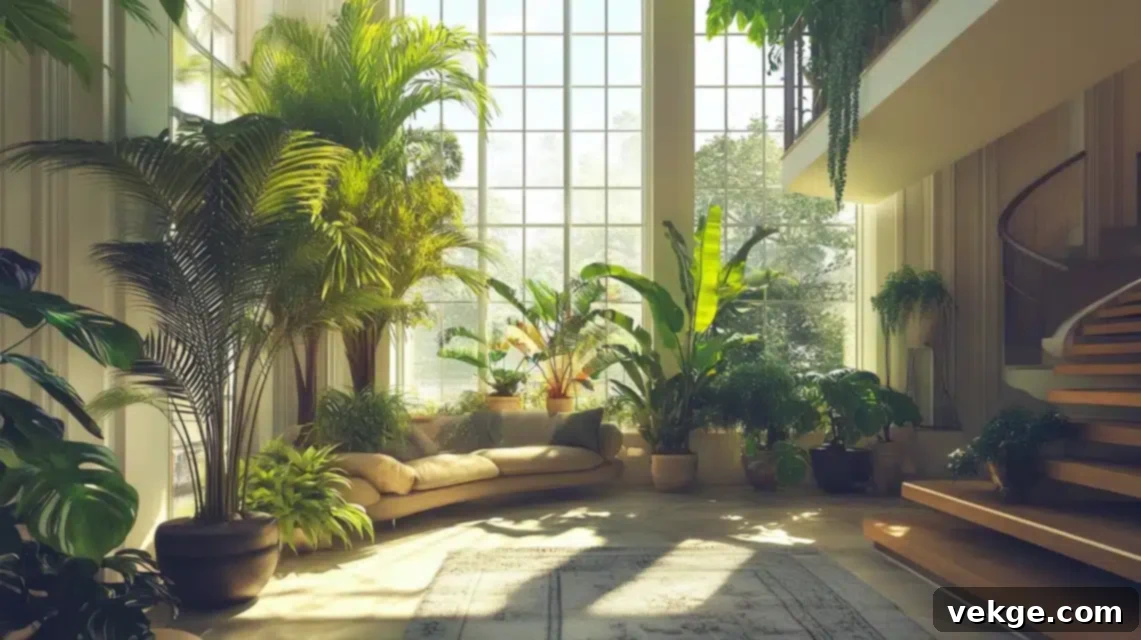
Bringing nature indoors is an excellent way to soften and fill high-ceiling spaces. Large indoor plants, particularly those with an upward growth habit, are perfect for corners or beside tall furniture. Varieties like Ficus trees, Areca Palms, or Dracaenas can reach impressive heights, naturally drawing the eye up and occupying empty vertical space with organic, living beauty. They add a touch of freshness and vibrancy, making the room feel more alive and less stark.
A substantial indoor plant, such as a Ficus or a mature Palm, typically ranges from $50-150, depending on its size. Allocate an additional $25-50 for a large, decorative pot that complements your décor. Placing these majestic plants in strategic corners allows them to grow upward, creating a natural and effortless way to fill those empty vertical spots, connecting the floor with the upper reaches of the room.
4. Elegant Hanging Lights ($100-500)
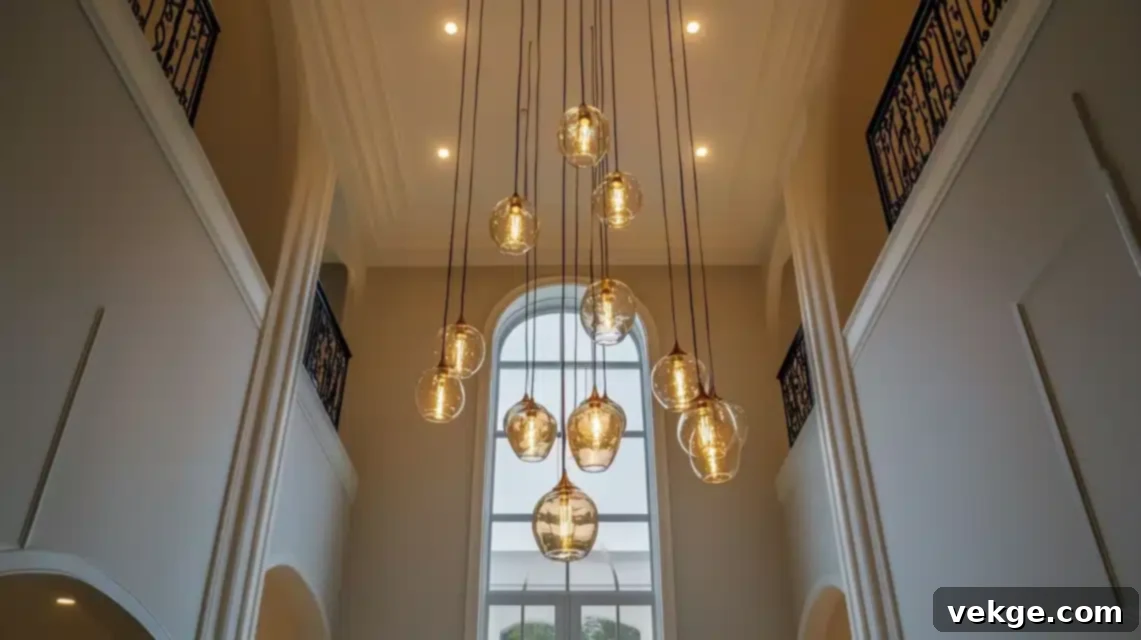
Long pendant lights or a stunning chandelier can be particularly impactful in rooms with high ceilings. These fixtures serve as both functional lighting and significant decorative elements, drawing the eye down from the ceiling and visually lowering the perceived height. The key is to ensure they hang at an appropriate level, typically extending down about one-third of the total ceiling height, to effectively connect the upper and lower halves of the room. This creates a more cohesive and welcoming atmosphere.
While basic pendant lights can start around $100, more elaborate chandeliers might range from $300-500. Keeping an eye out for sales can yield significant savings. For optimal effect in tall rooms, aim for a drop length of approximately 2-3 feet (or more, depending on ceiling height) from the ceiling to the bottom of the fixture, ensuring it hangs within the visual plane of the room’s main activities.
5. Illuminating Large Mirrors ($100-300)
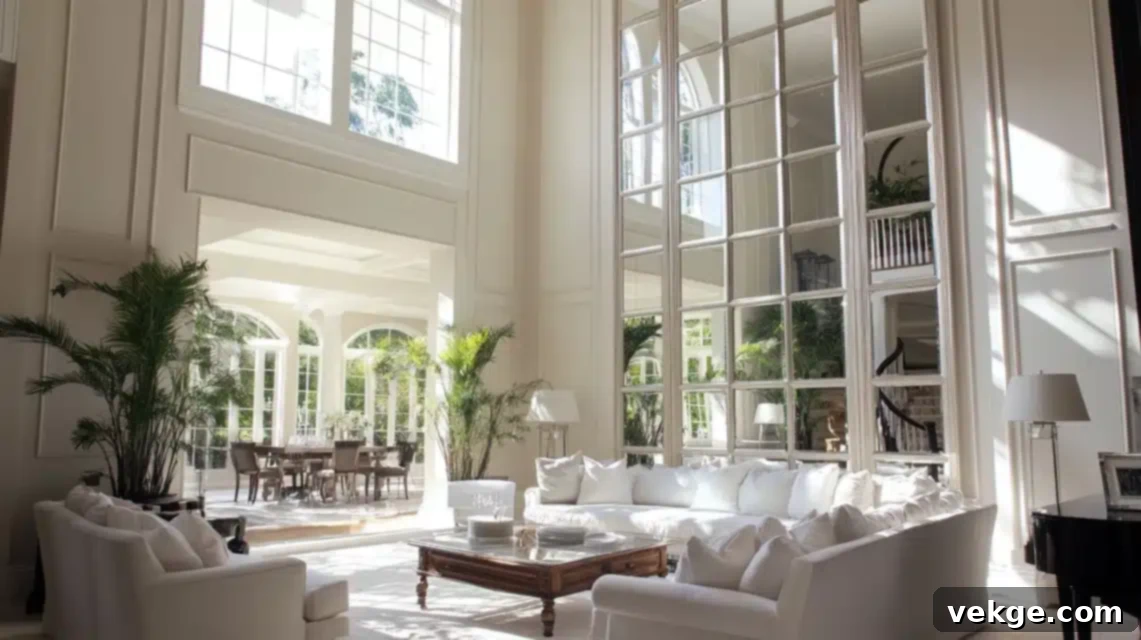
Strategically placed tall mirrors on your walls can work wonders in rooms with high ceilings. Not only do they create an illusion of greater space and depth, making rooms feel larger than they are, but they also significantly amplify natural and artificial light. By reflecting light upwards and across the room, mirrors help distribute brightness throughout the vertical expanse, ensuring that even the highest points feel illuminated and integrated into the overall design. Leaning a full-length mirror against a wall can also add an effortless, stylish touch.
Floor-length mirrors can be found for $100-300, with prices varying based on size, frame material, and style. Many home décor stores offer excellent options. These reflective surfaces are not just decorative; they are functional tools that enhance luminosity and create dynamic visual interest, making high-ceiling rooms feel more expansive and thoughtfully decorated.
6. Functional Wall Shelves ($80-200)
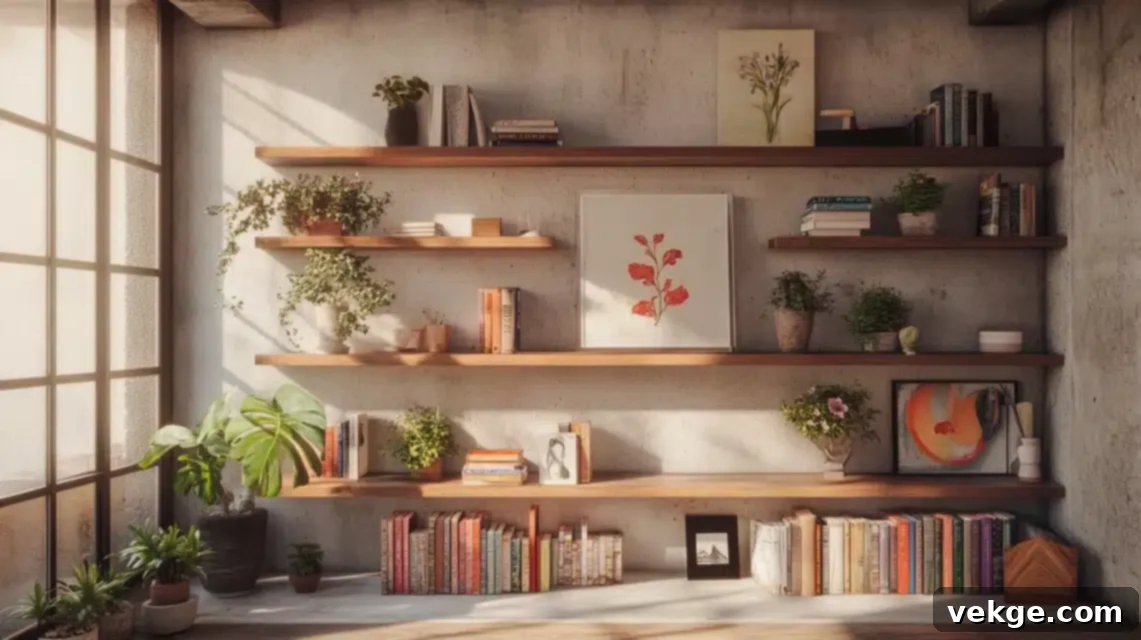
Installing floating shelves at varying heights offers both decorative potential and practical storage in a tall room. These shelves provide elevated platforms for showcasing books, small potted plants (especially trailing varieties), decorative objects, and framed photos. This method effectively breaks up large expanses of wall, adding layers of interest and personality without making the room feel cluttered. Arranging them creatively can guide the eye upwards, engaging the full height of the space.
Good quality floating shelves typically cost $20-40 each. For a significant impact, consider using four to six shelves. Remember to allocate an additional $20 or so for robust mounting hardware to ensure safety, especially when decorating at height. Spacing them out vertically with careful consideration for balance and visual flow will create a dynamic display that fills the space effectively.
7. Soft Fabric Panels ($50-150)
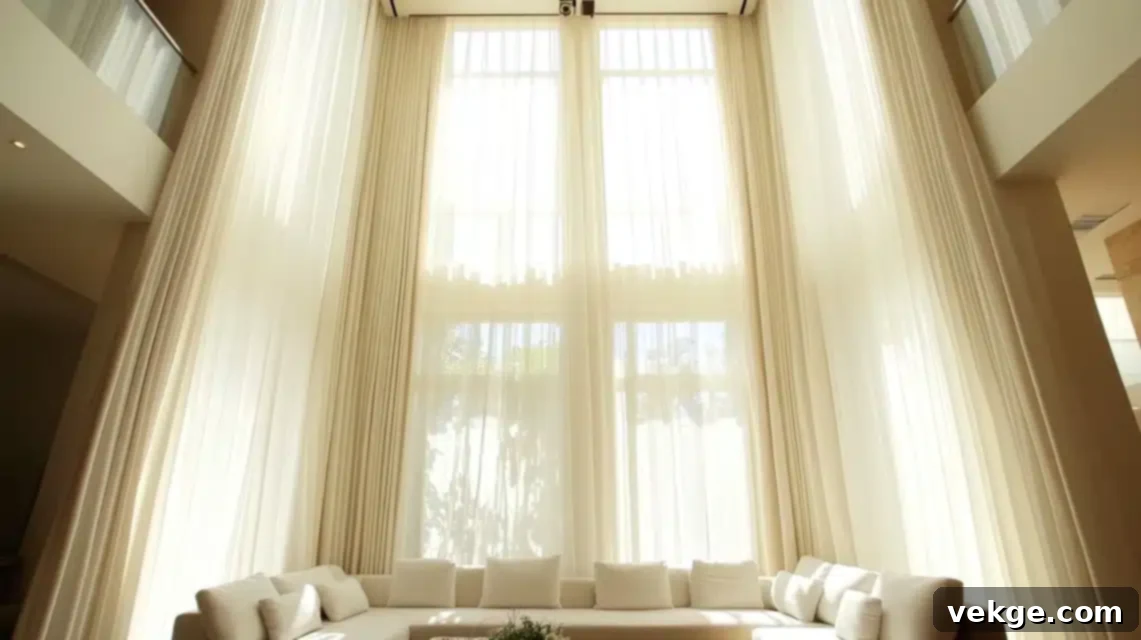
Floor-to-ceiling curtains or fabric panels are a remarkably effective way to add softness, texture, and visual interest to tall walls. When hung high and allowed to drape gracefully to the floor, they create a sense of grandeur while simultaneously making the room feel less empty and more luxurious. The vertical lines of the fabric draw the eye up, emphasizing the height in an elegant manner, and can even help with acoustics in large spaces. Choose light-colored or patterned fabrics to add brightness and personality.
Long curtain panels typically cost between $25-75 per panel, depending on material and length. For most standard windows, using two panels will create a fuller, more substantial look. Look for “extra-long” or “floor-to-ceiling” ready-made panels to ensure they achieve the desired dramatic effect. Hanging curtain rods several inches above the window frame, extending slightly wider than the window itself, will further enhance the perceived height and width of your windows and walls.
Choosing the Best Colors for Rooms with High Ceilings
The right color palette can transform a high-ceiling room from austere to inviting. The key is to use color strategically to manipulate perception and create warmth:
- Light Upper Colors ($40-60 per gallon): For the highest sections of your walls and the ceiling itself, soft whites, light grays, or pale blues are ideal. These ethereal colors make the ceiling feel less distant and more approachable, visually “lowering” it without making the space feel cramped. They also excel at reflecting light, brightening the entire room and preventing a dark, cavernous feel up high.
- Mid-tone Middle Areas ($40-60 per gallon): For the main expanse of the walls, encompassing the middle section, opt for medium shades. Warm beige, soothing sage green, or soft gold can provide a gentle transition between the grounded lower third and the airy upper section. These colors allow the eye to move smoothly up the wall, contributing to a harmonious flow and adding a layer of sophisticated warmth.
- Deeper Lower Colors ($45-65 per gallon): To effectively ground the room and create a cozy, intimate feel at floor level, select richer, slightly darker versions of your middle-section colors for the bottom third of the wall. Consider shades like deep cream, warm chocolate brown, steel blue, or even a deep charcoal. This strategy anchors the space, making the furniture and lower decor feel more connected and comfortable.
Color Matching Tips:
- Always test colors in small, inconspicuous spots on your walls before committing.
- Observe the tested colors under various lighting conditions – natural daylight, evening lamps, and overhead fixtures – as light dramatically alters perception.
- Ensure your chosen wall colors harmonize with your existing furniture, rugs, and decorative accents.
- Aim to stick to a cohesive palette of 2-3 main colors per room to maintain elegance and prevent visual chaos.
Natural Color Ideas for High Ceilings:
- **Sandy Browns with Cream:** A timeless combination that evokes natural warmth and grounded sophistication.
- **Soft Gray with White:** Modern and airy, this pairing offers a clean, serene backdrop that feels expansive yet refined.
- **Pale Green with Ivory:** Brings a sense of calm and nature indoors, creating a fresh and inviting atmosphere.
- **Light Blue with White:** Perfect for a serene, uplifting space that feels open and breathable.
These thoughtful color combinations work synergistically, preventing the room from feeling overwhelmingly vast or, conversely, too busy and closed-in.
Optimal Lighting Fixtures for Rooms with Tall Ceilings
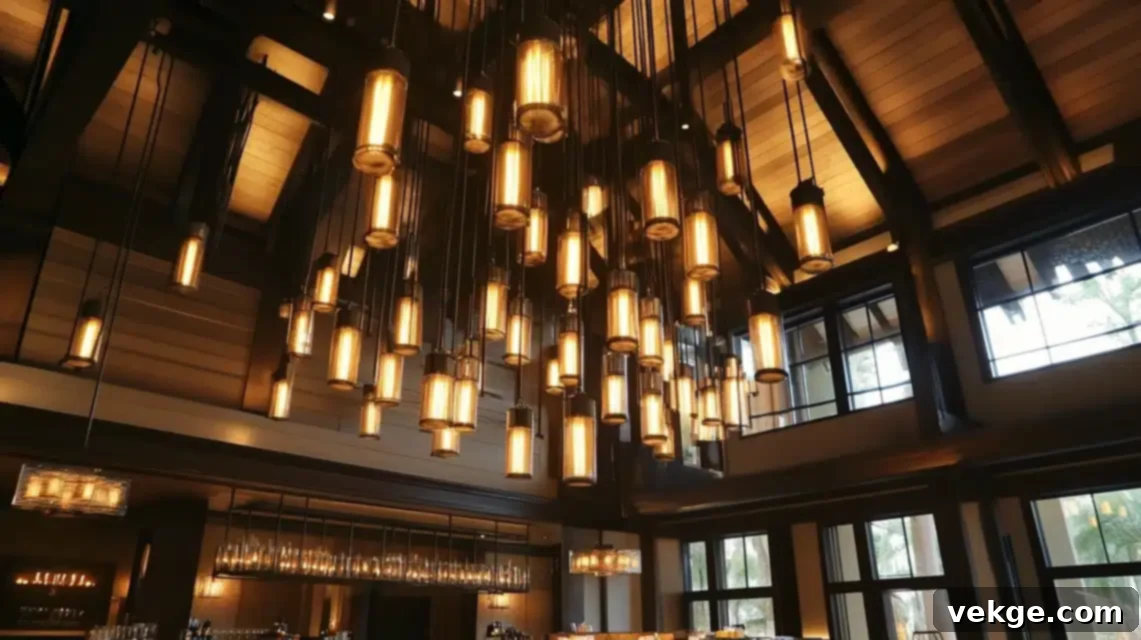
Effective lighting is paramount in high-ceiling rooms to prevent dark corners and create a layered, inviting ambiance. Here’s a breakdown of fixture types and placement strategies:
1. Ceiling Fixtures ($200-600)
- Long-Chain Chandeliers: These are ideal for entryways, grand living areas, or above dining tables where they can truly shine as a central design element. Their extended drop helps bring the light source closer to eye level, diminishing the vastness of the ceiling.
- Placement: Typically, the bottom of the chandelier should hang approximately 7-8 feet above the floor in living areas, or about 30-36 inches above a dining table.
- Large Pendant Lights: Over kitchen islands or dining tables, large pendants can provide focused illumination while also serving as stylish visual anchors.
- Multiple Smaller Pendants: Arranging several smaller pendants in a cluster or linear fashion can create a modern, artful statement that fills vertical space effectively.
2. Wall Lights (Sconces) ($50-150 each)
- Strategic Illumination: Wall sconces are excellent for adding ambient light and highlighting specific wall sections, breaking up large expanses. They create a more intimate atmosphere by directing light horizontally or both upwards and downwards.
- Placement: Install sconces at eye level (around 60-66 inches from the floor) or in pairs around architectural features like fireplaces or large mirrors to add visual interest and balance.
- Versatility: Use two or three sconces on a tall wall to illuminate dark spots or define distinct zones, providing both functional and decorative light.
3. Floor Lighting ($75-200)
- Vertical Fill: Tall floor lamps, especially arc lamps that bend over seating areas, are perfect for extending light upwards and filling empty vertical corners. They contribute to a layered lighting scheme and offer practical task lighting for reading or conversation.
- Placement: Position floor lamps in corners, beside sofas, or next to armchairs to provide focused light and soften the edges of the room.
- Style Integration: Choose lamps that complement your room’s aesthetic, from minimalist designs to more elaborate statements.
4. Track Lighting ($150-400)
- Flexible Accentuation: Track lighting offers incredible versatility for illuminating tall walls, especially for showcasing artwork, architectural details, or built-in shelving. The individual lights can be adjusted and directed precisely where needed.
- Adaptability: This system is easy to reconfigure, making it ideal for those who frequently change their décor or art collection. It ensures that every element, no matter how high, can be properly lit.
General Placement Tips:
- **Even Spacing:** Distribute light sources evenly across walls and ceiling to avoid “hot spots” or dark zones.
- **Layered Lighting:** Combine ambient (general), task (focused), and accent (decorative) lighting to create depth and functionality.
- **Focal Points:** Use accent lights to draw attention to special features, artwork, or architectural details high on the walls.
- **Dimmer Switches:** Install dimmers on all lighting circuits to easily adjust the mood and intensity of light, crucial for adapting a high-ceiling room for different occasions.
Budget-Friendly Lighting Options:
- Simple pendant lights or multi-light bars can start from $100.
- Basic wall sconces can be found for around $50 each.
- Stylish, functional floor lamps begin at $75.
- Consider string lights or strategically placed uplights for temporary or cost-effective solutions to add ambiance.
Installation Notes for High Ceilings:
- Always ensure that ceiling fixtures for tall rooms come with sufficient chain or downrod length.
- Some heavier or larger fixtures may require special mounting hardware or additional ceiling support.
- For safety and proper installation, especially for very high ceilings, it’s often best to hire a professional electrician.
- Always check the weight limits for ceiling mounts before purchasing large fixtures.
By thoughtfully combining these lighting options, you can effectively fill vertical space with illumination, create inviting atmospheres, and highlight the unique grandeur of your tall-ceiling rooms.
Integrating Modern Technology with High Ceilings
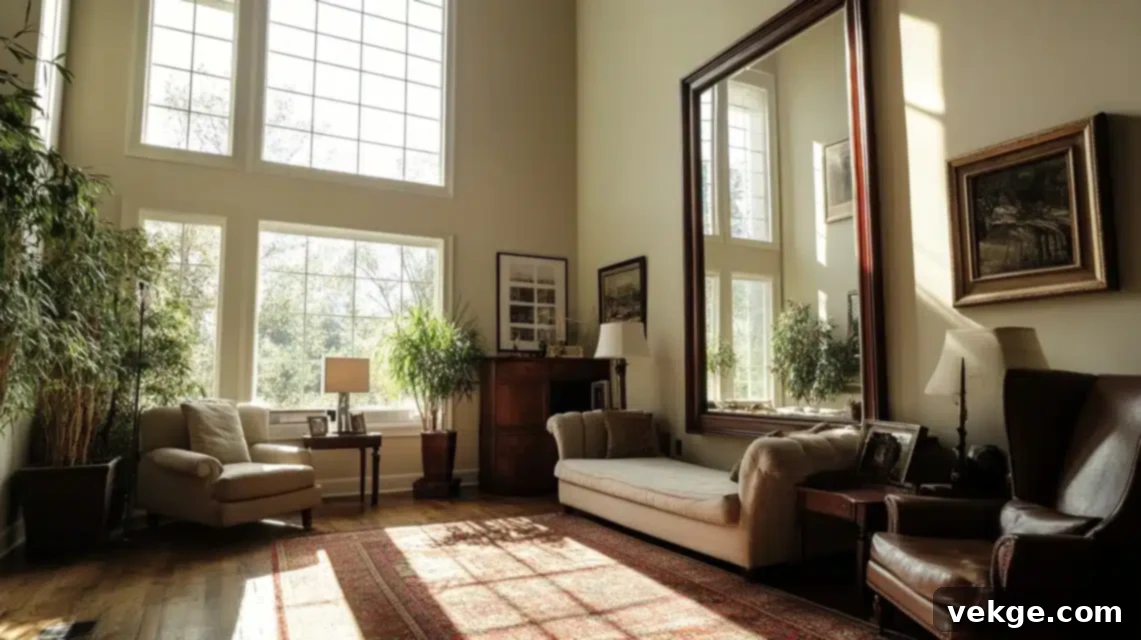
Modern technology can significantly enhance the comfort and functionality of high-ceiling homes, offering convenience and seamless integration into the grander scale of the space:
- Hidden TV Systems ($300-800): For minimalist aesthetics, flat-screen TVs can be mounted higher on walls, out of the primary sightline when not in use. Innovative solutions like TV lift cabinets or art-concealing frames can hide screens completely, preserving the elegance of a tall wall. This keeps the room looking clean and free from technological clutter, allowing the architecture and decor to shine.
- Smart Lighting Solutions ($100-400): Managing lighting in a high-ceiling room can be simplified with smart technology.
- Voice-controlled bulbs: Easily adjust brightness or turn on/off high-mounted fixtures without needing a ladder.
- Phone-controlled dimmers: Fine-tune the ambiance from anywhere in the room.
- Light sensors: Automate lights to turn on at sunset or when motion is detected.
- Time-set programs: Schedule daily lighting routines for convenience and energy efficiency.
- Motorized Blinds and Shades ($200-500): Tall windows are magnificent but challenging to manage. Motorized blinds or shades, controlled via remote, smartphone app, or even voice commands, eliminate the need for manual adjustment. They can open and close automatically, providing privacy, light control, and insulation with unparalleled ease.
- Integrated Sound Systems ($250-600): High ceilings often mean larger volumes, making sound distribution important.
- Small, strategically placed speakers: Discreetly mounted high on walls or integrated into the ceiling can provide immersive, room-filling sound.
- Wall-mounted soundbars: Offer a sleek audio solution beneath a wall-mounted TV.
- Built-in ceiling speakers: Deliver unobtrusive, high-quality audio that permeates the entire space without visible clutter.
- Smart Temperature Control ($150-300): High ceilings can lead to heat stratification, with warm air rising.
- Smart fans: With remote controls or smart home integration, these fans can efficiently circulate air, preventing warm air from pooling at the ceiling and ensuring consistent comfort throughout the room.
- Smart thermostats: Can learn your habits and optimize heating/cooling to manage the larger volume of air more effectively.
- Long-Reach Cleaning Tools ($100-200): Maintaining cleanliness at height can be daunting.
- Extension poles: With various attachments (dusters, window squeegees), these make reaching cobwebs and dust easy.
- Robotic window cleaners: For truly expansive, inaccessible windows, these devices can be a godsend.
These technological integrations not only make living with high ceilings infinitely simpler and more enjoyable but also add a layer of modern sophistication and efficiency to your home.
Budget-Friendly Decorating Ideas to Consider for High Ceilings
You don’t need a lavish budget to create a stunning high-ceiling room. Many impactful decorating ideas are surprisingly affordable and can be achieved with a bit of creativity:
- DIY Large-Scale Wall Art ($50-100): Instead of purchasing expensive oversized art, create your own. Large canvases can be bought affordably from craft stores. Experiment with simple abstract designs, geometric patterns, or color-block paintings using acrylics. Even stretched fabric panels with interesting textures or patterns can make a statement. The impact of a large, custom piece is significant, and the cost is minimal.
- Smart Window Treatment Tricks ($75-150):
- Buy longer curtains on sale: Keep an eye out for extra-long panels during sales or at discount stores. Length is key for high windows.
- Use plain panels in pairs: Two simple, solid-colored panels per window, hung high, create a dramatic and elegant effect.
- Add trim to basic curtains: Elevate inexpensive curtains by sewing on decorative trim, ribbon, or tassels for a custom look.
- Hang them high above windows: Install curtain rods several inches (or even a foot) above the window frame to visually extend the height of the walls.
- Whimsical Paper Lantern Clusters ($30-80): Grouping paper lanterns of various sizes and at different hanging heights can create a playful, inexpensive, and visually captivating installation. White or cream lanterns offer a clean, airy look, while colored ones can add a pop of personality. They fill significant vertical space without feeling heavy or permanent.
- Bold Painted Stripes ($40-100):
- Paint horizontal lines: While counter-intuitive for height, wide horizontal stripes in a high-ceiling room can visually “expand” the width and reduce the perceived vertical stretch, making the room feel more balanced and intimate.
- Use two similar colors: Opt for subtle contrast between two closely related shades to avoid a jarring effect.
- Mark lines with tape: Use painter’s tape to create crisp, clean lines.
- Paint every other space: This method saves paint and creates a rhythmic pattern.
- Used Furniture Makeovers ($100-200): Hunt for tall bookcases, display cabinets, or armoires at thrift stores, yard sales, or online marketplaces. A fresh coat of paint, new hardware, or even contact paper can completely transform these pieces. Tall furniture acts as excellent vertical anchors, filling space and providing valuable storage or display areas.
- DIY Vertical Plant Wall ($60-120):
- Buy small, trailing plants: Choose varieties that will cascade or climb.
- Hang them in rows: Use wall-mounted planters or simple hooks with hanging pots.
- Use simple pots: Terracotta or basic ceramic pots keep costs down.
- Let them grow up and down: Encourage vines to grow upwards on clear fishing line or small trellises, or let trailing plants cascade downwards, creating a lush, living wall feature.
- Impactful Wall Decals ($20-50): Large wall stickers or decals offer an incredibly affordable and commitment-free way to fill tall wall spaces. Choose simple, elegant patterns, nature-inspired motifs, or even a faux mural effect. They are easy to apply, remove, and change, making them perfect for renters or those who like to frequently update their decor. Pick designs that naturally draw the eye upwards.
By mixing and matching these creative and budget-friendly ideas, you can achieve impressive results and craft a beautifully decorated high-ceiling room that reflects your style without incurring significant expense.
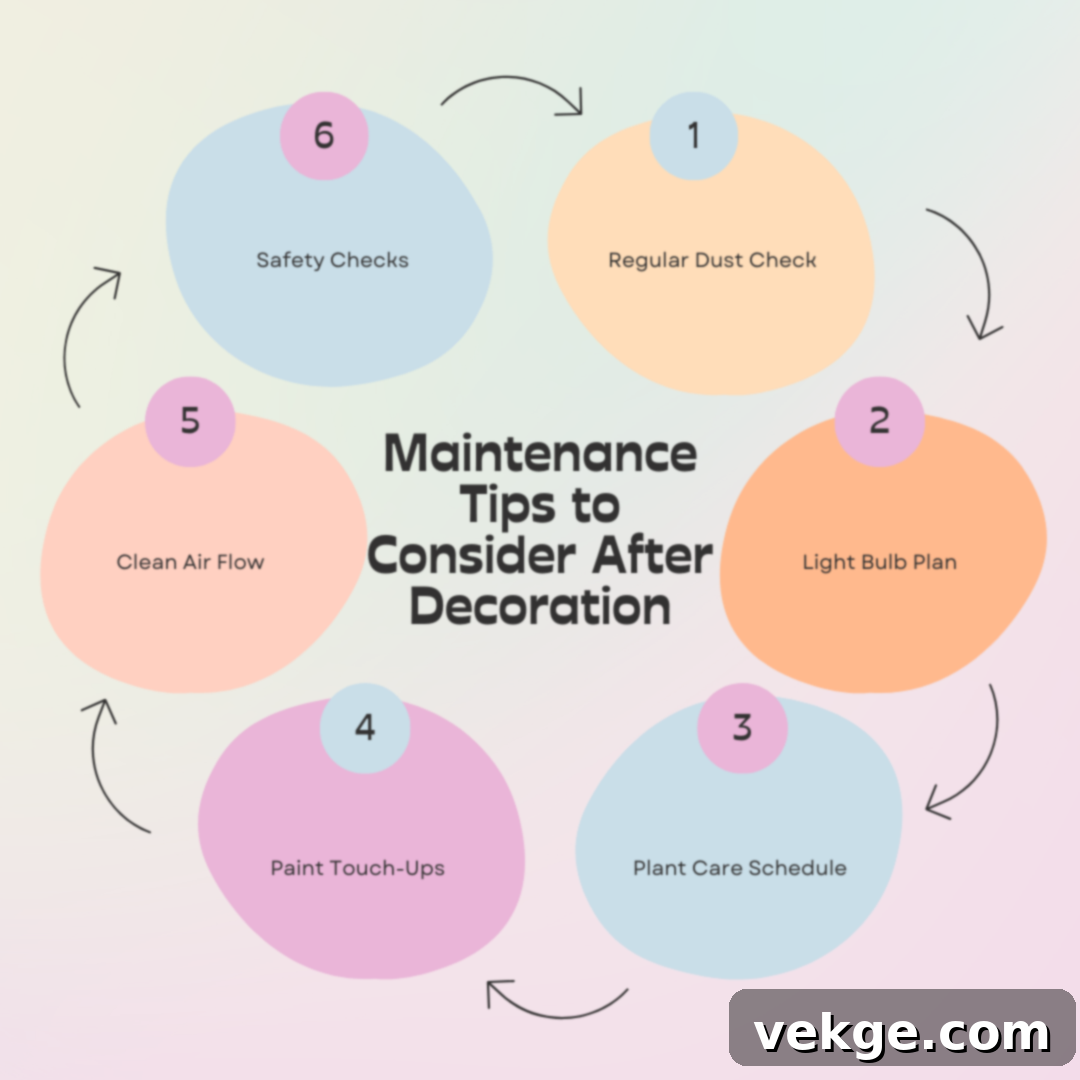
Conclusion
High ceilings, while initially presenting a unique design challenge, are ultimately a magnificent architectural feature that can be transformed into the most captivating elements of your home. Like many, I once found myself navigating the puzzle of these towering spaces, but with the right strategic approach, they can become embodiments of warmth, comfort, and sophisticated style.
Remember, the journey to a beautifully decorated high-ceiling room doesn’t require an overnight transformation. You don’t need to implement every idea simultaneously. Begin by selecting one or two suggestions that resonate most with your vision and budget. Try adding a dramatic lighting fixture, introduce a few tall plants, or experiment with a two-tone paint scheme on a single wall. Taking small, manageable steps allows you to observe what works best for your specific space and personal taste, gradually building a cohesive and inviting environment.
I’m genuinely excited to hear about your own creative ventures in styling tall ceilings. Please share your insights, triumphs, and unique decorating ideas in the comments section below! Your experiences can inspire and guide others on their design journeys.
For those eager to explore further home design inspiration, I invite you to check out my companion guide on “Making Small Spaces Feel Bigger.” Many of the principles and tricks discussed there, particularly regarding visual expansion and clever utilization of space, complement the strategies for decorating high ceilings beautifully.
Frequently Asked Questions About Decorating High Ceilings
What Window Treatments are Ideal for Tall Windows?
For tall windows, the most impactful treatment is floor-to-ceiling curtains. Opt for light, flowing fabrics such as linen or cotton blends to maintain an airy feel. I often layer sheer panels underneath solid ones; this combination provides versatile control over natural light and privacy. For added function or a more defined look on the lower half, consider pairing these curtains with simple blinds or Roman shades, which can be operated independently for privacy without obscuring the upper window.
How Do I Balance Large Wall Spaces without Feeling Overwhelmed?
The key to balancing large wall spaces is to break them down into more manageable visual sections. Instead of a single, enormous piece of art, I recommend creating art groupings or gallery walls using three or more medium-sized pieces. These arrangements appear more dynamic and proportional. Start hanging your primary artwork at eye level, then gradually extend the arrangement upwards. Incorporating other elements like wall sconces, floating shelves, or decorative wall panels can further segment the wall, adding depth and interest without making the space feel cluttered or overwhelming.
How Do I Fill the Empty Vertical Space in My Living Room?
To effectively fill empty vertical space in a high-ceiling living room, a multi-faceted approach works best. Combine tall, slender bookshelves or custom built-ins that extend high up the wall, using them for books and decorative items. Integrate climbing plants on shelves or with decorative trellises to add organic texture. Wall sconces placed at varying heights can introduce ambient light and visual breaks. Additionally, a strategically placed large mirror will not only fill vertical space but also reflect light and views, making the room feel more expansive and complete. Consider a dramatic, elongated pendant light or chandelier to draw the eye downwards and create a central focal point.
